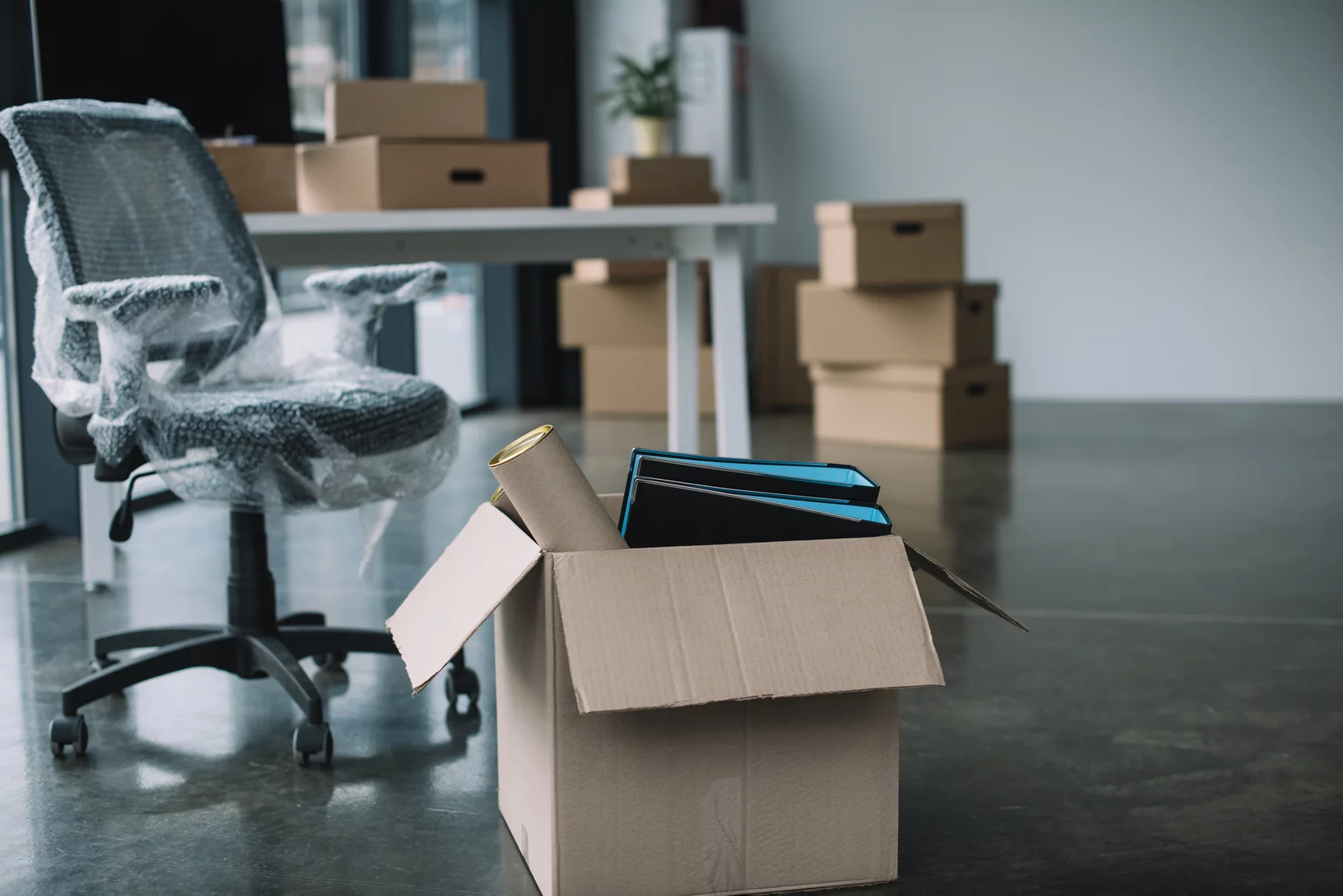When moving office equipment, it’s crucial to determine the best way to pack and transport the items. Fragile devices such as computers, monitors, and projectors should be packaged carefully with plenty of padding. To ensure the safety of your electronics, consider hiring professional movers with experience packing and transporting delicate electronics. Professional movers know the proper techniques to prevent damage during transit.
Moving office equipment is complex and requires careful planning and execution to ensure a smooth and successful move. Here are some expert tips and advice on how to move your office equipment:
Create an Office Move Plan
Creating a moving plan is an essential step when preparing for a move. A comprehensive plan will help you stay organized and ensure you notice all the necessary details. Here are some tips and directions on how to create a moving plan:
Determine the Timeline: The first step in creating a moving plan is to determine the timeline of the move. Decide on the moving date and the date you need to be out of your current location. This will help you determine how much time you have to prepare.
Create a Checklist: Create a checklist of all the tasks that must be completed before the move. This should include everything from packing to disconnecting utilities to forwarding mail. A list will help you stay organized and ensure you get everything necessary.
Determine the Budget: Determine how much you can afford to spend on the move and create a budget. This will help you determine how much you can spend on professional movers, packing supplies, and other expenses.
Pack Efficiently: Make sure to label all boxes clearly with their contents and the room they belong in. This will make unpacking and setting up in the new location easier. Pack fragile items carefully, and consider using bubble wrap or other protective materials.
Change Your Address: Make sure to change your address with the post office, banks, credit card companies, and any other organizations that need to know your new location.
Notify Utility Companies: Notify utility companies such as electricity, water, and gas of your move-out date and arrange for disconnection at the old location and connection at the new site.
Clean the Old Space: Clean it thoroughly before leaving your old location. This will ensure you get your full security deposit back and leave the space in good condition for the next occupants.
Unpack Efficiently: When unpacking, prioritize items you need immediately, such as toiletries and changing clothes. Unpack one room at a time to stay organized and avoid feeling overwhelmed.
Hire Professional Movers
Hiring professional movers can make your move less stressful and more efficient. Professional movers have the necessary experience, equipment, and expertise to transport your belongings to your new location safely. Here are some tips and directions on how to hire professional movers:
Research Several Companies: Research several moving companies in your area and read reviews. Ask friends and family for recommendations as well. Make sure to choose a company that is licensed, insured, and has a good reputation.
Get Multiple Quotes: Contact several moving companies and get multiple quotes. Compare the prices and services each company offers to find the best deal.
Ask for References: Ask each company for references from past customers. Follow up with these references to understand their experience with the company.
Discuss Your Needs: Discuss your specific moving needs with the company. This includes the size of your move, any fragile items that need to be moved, and any other special requirements.
Check for Hidden Fees: Ask about hidden fees or charges that may not be included in the initial quote. For example, some companies may charge extra for stairs or long carries.
Consider Insurance Options: Consider the insurance options offered by each company. Ensure that your belongings are fully covered during the move in case of any damages or losses.
Read the Fine Print: Before signing a contract, read the fine print and understand all terms and conditions. Make sure to clarify any questions or concerns you may have.
Prepare for the Move: When hiring a moving company, prepare. Label all boxes clearly, pack fragile items carefully, and disconnect any appliances or electronics.
Update Your Insurance
If you’re considering moving insurance, you should keep several essential tips and directions in mind. Here are some things to consider:
Assess your current coverage: The first step in moving insurance is to assess your recent coverage. Take a close look at your policy to determine your insurance types, coverage limits, and deductibles.
Research your options: Once you know what you’re currently covered for, it’s time to research them. Look for policies from reputable insurance companies that offer the coverage you need at a price you can afford.
Compare rates: When you’re evaluating different insurance policies, make sure to compare rates from multiple providers. This can help you find a more affordable insurance policy or better coverage than your current one.
Understand the transition process: Before you switch insurance, make sure you understand the transition process. You’ll need to cancel your current policy and set up a new one, and there may be fees or penalties associated with cancelling early.
Consider timing: If you’re switching insurances mid-policy, you’ll want to ensure you’re not leaving yourself uncovered during the transition period. Ensure your new policy starts before you cancel your old one to avoid any lapses in coverage.
Review your new policy carefully: Review your new insurance policy before signing the dotted line. Ensure you understand the coverage limits and deductibles, and ask questions if anything needs clarification.

Label All Equipment and Office Furniture
Labelling all equipment is an essential step in organizing your new office space. Here are some tips and directions for marking your equipment:
Choose a labelling system: There are many different ways to label equipment, so you must choose the best plan. Some options include pre-printed labels, custom labels, or colour coding.
Determine what information to include: When labelling your equipment, it’s essential to have key information to help you identify each item. This might include the item’s name, model number, serial number, or purchase date.
Use durable labels: To ensure your labels stay in place and remain legible, use durable labels designed to withstand wear and tear. Vinyl or polyester labels are good choices for equipment exposed to moisture, heat, or chemicals.
Label all equipment: Labelling your gear is essential, even if it seems easy to identify. This will help you keep track of everything and make it easier to locate items when you need them.
Keep labels consistent: To avoid confusion, it’s essential to keep your labelling system consistent across all your equipment. This means using the same font, size, and colour for all labels.
Update labels as needed: Equipment may need to be replaced or updated over time. Make sure to update the tags on your equipment accordingly to ensure accurate tracking.
Back-Up Data
Backing up your data before moving is crucial to transfer all digital information to your new location safely. Here are some tips and directions for backing up your data before moving:
Choose a backup method: There are different ways to backup your data, including cloud storage, external hard drives, and USB drives. Consider what works best for you based on the type of data you need to backup and how much storage space you require.
Backup all important data: Make sure to backup all important data like work documents, personal photos, music, and other files you don’t want to lose. You can start by creating a list of everything you want to save and prioritize accordingly.
Test your backups: Once you’ve backed up your data, it’s important to test the backup to ensure your data is properly stored and can be easily retrieved if needed. This will prevent any surprises when you’re trying to restore your data.
Keep the backup separate: After you’ve backed up your data, keep it separate from your computer equipment or any items that could damage it. You can store it in a different location or with a trusted friend or relative.
Use encryption: If you’re storing sensitive data, use encryption to protect it from unauthorized access. This will help ensure that your data remains secure even in transit.
Verify that all data has been backed up: Before moving, double-check to ensure that all of your data has been backed up and that you have caught everything important. It’s better to be safe than sorry.
Dispose of Old Equipment
Protecting your data and the environment is vital when disposing of unneeded equipment. It also makes moving much lighter and faster when you don’t bring all of your clutter during commercial moves.
Here are some tips and directions for disposing of unneeded equipment before office moving:
Wipe all data before disposing of any equipment, wipe all data from the hard drive. This will help ensure your personal information is in the right hands. You can use software designed to wipe data securely or take the hard drive out and physically destroy it.
Consider recycling: Many electronic devices contain hazardous materials like lead, mercury, and cadmium that can harm the environment if not disposed of properly. Consider recycling your equipment with a certified e-waste recycler to limit environmental impact.
Donate or sell: If the equipment is still functional, consider donating it or selling it to someone who could use it. This will help extend the life of the equipment and prevent it from going to waste.
Check local regulations: Be sure to check local laws regarding the disposal of electronic equipment. Some localities have specific requirements for how electronic waste must be disposed of, so it’s important to research beforehand.
Remove batteries: Remove batteries from any equipment you dispose of. Batteries can be recycled separately and may have different disposal requirements than the device.
Keep records: Keep records of the serial numbers and other identifying information of the equipment you’re disposing of. This will help you track what you’ve disposed of and when.
Prepare Your New Office Space
Preparing your new space is important to ensure a comfortable, organized, and functional home or workplace. Here are some tips and directions for training in your new area:
Clean and sanitize: Before moving in your belongings, clean and sanitize the entire office space thoroughly. This will help ensure that you’re starting with a fresh slate and that your space is free of germs or allergens.
Plan your layout: Take some time to plan out the layout of your new space before moving in your furniture and belongings. Consider natural light, traffic flow, and storage when arranging furniture prior to the actual office relocation.
Install storage solutions: Install shelves, cabinets, and other storage solutions to help keep your space organized and clutter-free after a commercial relocation. This will help you make the most of your office spaces and keep your belongings easily accessible. Giving staff their own desks will also help them organize office supplies and specialized equipment as well as their personal belongings when they report to work.
Set up utilities and services: Make sure to set up your utilities and services (like internet, cable, and phone) as soon as possible. This way you can have the necessary resources up and running after you move in.
Personalize your space: Add personal touches like artwork, photos, and décor to make your new room feel like home. This can help you settle in and make the space your own.
Check for safety hazards: Ensure your new space is free from hazards like loose floorboards or exposed wires. which typically happens after a phone installation. Address any potential safety issues before the movers arrive with your belongings.
Conclusion
Moving office equipment is a complex process and can be stressful if you don’t plan properly. It’s important to create a comprehensive moving plan, hire professional movers, label all equipment, back up your data, dispose of unneeded equipment responsibly, update your insurance as needed, and prepare your new space for a smooth transition. When considering who to hire to help with your move, choose a reliable, reputable professional mover.
Quick & Easy Moving has the experience and expertise to transfer your office equipment to your new location safely. With their help, you can rest assured that office moving will be successful and stress-free.


